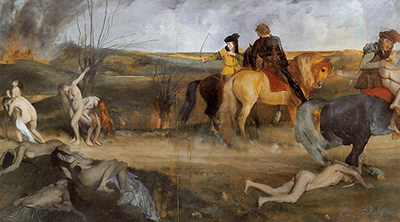Edgar Degas is immensely known for his impeccable artwork showcasing Impressionism with hints of realism.
Yet, the painting Scene Of War In The Middle Ages is a neoclassicism piece that showcases a scene from the Middle Ages. This piece is one of the artist's most prominent work, even though it clearly veers away from the classic Impressionism pieces Degas is well known for. Degas was believed to be 31 at time when he painted Scenes Of War In The Middle East. While the painting has such a distinct title, historians weren't able to actually link the work to a specific moment in history. Rather, it is unknown where exactly Degas obtained the inspiration from for the work.
Nevertheless, once Degas had passed, historians were able to interpret the work as Union American soldiers abusing women from New Orleans. Degas had once properly visited the state as his uncle owned a successful cotton business during the mid 1950s. Degas created numerous works inspired by his visit, such as The Cotton Exchange New Orleans. Scenes of War In The Middle East is a stunning painting as it significantly veers away from the common Impressionism pieces Degas painted. Rather, this piece has a more traditional touch to it as Degas goes for a neoclassical style. The beautiful painting is not only touched by a masterful technique, but also a captivating story. A soldier on his horse shoots a group of nude women at a time of chaos. Near the right of the painting three soldiers sit on their horses. The focal point of the piece is the man in yellow near the centre of the painting as he pulls his arrow back and points at a woman.
Degas made sure to bring the viewer's attention to this individual by using a bright colour to draw them in. This is a significant figure to acknowledge as he showcases the story. The viewer is left to wonder why a group of soldiers would hurt women distraught on the road. Near the prominent man, two soldiers sit on their horse and they ride away in the opposite direction. It is interesting to note that Degas decided to paint the horses in different colours. The three different horses in black, blonde, and grey give the illusion that the men are not organized coherently. Alongside, since the men are not dressed in the same uniform the viewer is left to wonder if perhaps these men even are soldiers.
While art critics have figured out the meaning behind the piece, it does not seem as clear upon initially looking on. The women in the painting are immensely distraught nude in the streets. To the left, one of the woman attempts to block the arrow with her hand. Another women with red hair bends towards the group. A few other women run in the opposite direction away from the men. It's interesting to note these women are all showcased with incredibly long hair. Since Edgar Degas created adored the female body in all her glory, it's only right that the artist decided to showcase these women with hair that flows as melodically as ballerina body movement.
Near the bottom of the piece in the direct, the viewer is able to spot three women that seem either dead or injured. A classic neoclassical landscape is seen in the background framing the piece. It's interesting to witness Degas use a centre perspective when creating the artwork, rather than the off the side view point he usually does. In the top left corner, the viewer can spot a house burning as dark clouds fill the sky. This setting most likely alludes to the idea that the soldiers had burned the women's house down. It is still immensely difficult to figure out why exactly the soldiers are abusing the women, yet the answer is buried away within the painting.




